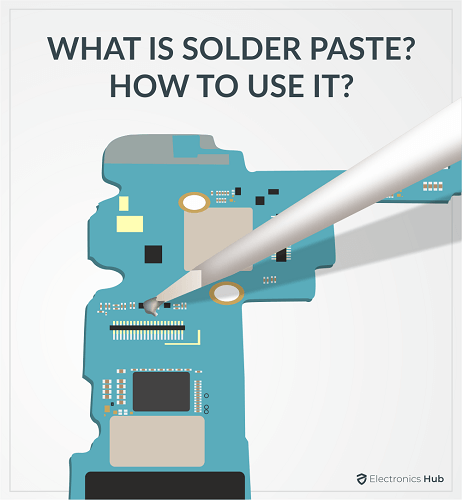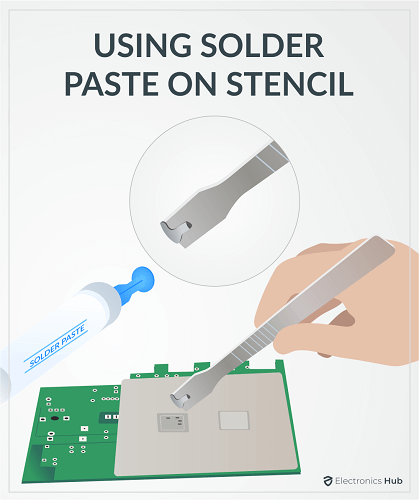Before you assemble the components, you have to make sure the surface of the board is free from impurities and oxidation. Otherwise, it will lead to short circuits and failure of the PCB. To prevent this, solder paste is used. Solder paste is made of flux and metal particles. The flux cleans the board surface and prevents further oxidation. Apart from acting as a protective coating, solder paste also strengthens the joints and allows current flow. The following is a detailed guide on the purposes of solder pastes, their types, and how to use them correctly.
What is a Solder Paste?
A solder paste is a metal alloy that melts to create a permanent bond between two metals. It is a combination of metal solder particles and sticky flux. One of the primary requirements of a solder paste is that it should have a low melting point. Only then it will melt sooner than the workpieces to create a joint. Solder paste is also a relatively good conductor of electricity. It allows solder paste to be used in joining electrical wires and assembling PCBs. Apart from creating a mechanical joint, solder paste also creates an electrical joint between them. Initially, the solder pastes were made from a mixture of tin and lead. Solder pastes used in electrical soldering consisted of 60% tin and 40% lead. But due to the harmful effects of lead, the modern solder pastes come without lead as well.
Solder Paste Grades
There are different grades of solder paste available to suit your soldering needs. You have to select the one depending on the type of soldering and the materials you want to solder. The solder paste is segregated into different grades based on the size of the solder balls. It is not possible to measure the exact size of the balls and grade them. So, the solder paste is graded in such a way that 80% of the balls fall within a size band. Here is a list of the different types of grades and the size of solder balls in each grade, Besides the size of solder balls, solder is also categorized into different types based on the flux type.
Rosin-Based Solder Pastes: As the name has it, these solder pastes consist of rosin. You can clean these fluxes after soldering by using solvents. Water Soluble Flux-Based Solder Pastes: They consist of glycol bases and organic materials. You can clean the water-soluble fluxes using cleaning agents that are readily available in the market No-Clean Solder Paste: The no-clean fluxes are made of resins and solid residues. The main advantage of using no-clean fluxes is that you do not have to spend any money on cleaning agents. But, you can not use this flux in all environments. You need to have a neat environment and an inert flow environment to use this flux.
How to Use Solder Paste?
Whether you are using the solder paste in mass PCB assembly or prototype PCB assembly, you have to follow certain steps precisely.
Soldering tools and equipment accessories Soldering iron tip Types of solders Types of soldering Micro soldering
First, you have to apply the solder paste on the circuit boards. While doing this, you have to make sure that you are applying only to the areas where you will be soldering. There are different methods to achieve this. We have listed two of the most popular methods to apply solder,
Using Stencil
The first method is by using a stencil. The stencil allows you to apply solder paste only in the areas you want. Place the stencil over the board and apply the solder paste through this. You have to make sure that you apply the required amount of solder paste. If you apply too little, the joints will not be strong and break easily. On the other hand, if you apply too much, the joints will become too large. Besides, it will lead to the possibility of shorts between adjacent pads.
Using Jet Printer
Although stencil does a good job in applying solder for mass PCB assemblies, you have to spend a lot of time building a stencil depending on the PCB assembly pattern. Besides, it is also difficult to control the amount of solder you apply to the board. A jet printer overcomes these drawbacks. But jet printing is not suitable for all solder paste types. The solder paste should be more liquid if you want to jet print it. The jet printer is programmed depending on the PCB assembly pattern. It has a cartridge in which you have to fill the solder paste. The printer then applies the correct amount of solder paste to the required areas on the board. Jet printing the solder paste provides more flexibility and increases the precision with which you apply the solder paste.
Assembling the Electronic Components
Once you have applied the solder paste on the circuit board, then you have to pass it through the pick and place machine. Like applying the solder, assembling the components on the solder also has different methods. To start with, you go with the pick and place machine. It is one of the simplest and easiest techniques. The pick and place machine adds the electrical components in the areas where you have applied the solder. There are different methods to assemble the electrical components on PCB. However, the pick and place machine offers the simplest and reliable way for PCB assembly. You may also opt for other methods such as reflow soldering. When the pick and place machine adds the components, the solder will hold the components due to the surface tension. During this stage, you have to keep two things in mind. You should not knock or disturb the board. If you do, the components might fall off. Also, if you take too long to solder the components, the solder paste will deteriorate and won’t hold the components.
Solder Paste Storage
When storing the solder paste, you have to make sure that the environment and temperature are suitable for it. If not, the solder paste will lose its properties and will become useless. Solder pastes are prone to oxidation due to the large surface of the solder spheres. So, to prevent this, you have to store them in airtight containers. Besides, you have to store them at low temperatures. Apart from minimizing the oxidation rate, the low temperature reduces the rate of degradation of the flux. However, you also have to make sure that the temperature does not drop below the freezing point. Every solder paste comes with a shelf life. You can see the shelf life on its label. Never use a solder paste beyond its shelf life. The joints created by these solder pastes won’t be strong nor reliable. Such joints will break easily and you will end up spending more to replace the entire circuit board.
Conclusion
Solder paste acts as a key element in the soldering process by creating reliable joints, allowing electrical conductivity, and protecting the workpieces against corrosion and oxidation. But, to achieve all these purposes, you need to choose the correct type of solder paste. Once chosen, you can apply the solder paste on the workpieces and use a relevant soldering technique to get the work done. If you have any other queries or doubts, let us know using the comments section. We will help you out. You can also post your thoughts and opinions in the comments box. Comment * Name * Email * Website
Δ







![]()